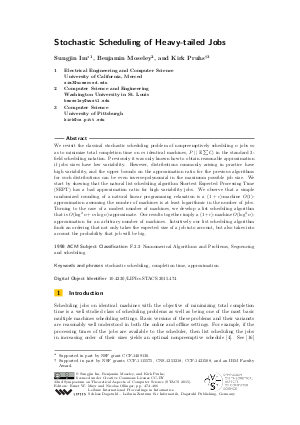Stochastic Scheduling of Heavy-tailed Jobs
Authors Sungjin Im, Benjamin Moseley, Kirk Pruhs
-
Part of:
Volume:
32nd International Symposium on Theoretical Aspects of Computer Science (STACS 2015)
Part of: Series: Leibniz International Proceedings in Informatics (LIPIcs)
Part of: Conference: Symposium on Theoretical Aspects of Computer Science (STACS) - License:
 Creative Commons Attribution 3.0 Unported license
Creative Commons Attribution 3.0 Unported license
- Publication Date: 2015-02-26
File

PDF
LIPIcs.STACS.2015.474.pdf
- Filesize: 0.65 MB
- 13 pages
Document Identifiers
Subject Classification
Keywords
- stochastic scheduling
- completion time
- approximation
Metrics
- Access Statistics
-
Total Accesses (updated on a weekly basis)
0Document
0Metadata
Abstract
We revisit the classical stochastic scheduling problem of nonpreemptively scheduling n jobs so as to minimize total completion time on m identical machines, P \mid \mid \mathbb{E} \sum C_j in the standard 3-field scheduling notation. Previously it was only known how to obtain reasonable approximation if jobs sizes have low variability. However, distributions commonly arising in practice have high variability, and the upper bounds on the approximation ratio for the previous algorithms for such distributions can be even inverse-polynomial in the maximum possible job size. We start by showing that
the natural list scheduling algorithm Shortest Expected Processing Time (SEPT) has a bad approximation ratio for high variability jobs. We observe that a simple randomized rounding of a natural linear programming relaxation is a (1+\epsilon)-machine O(1)-approximation assuming the number of machines is at least logarithmic in the number of jobs. Turning to the case of a modest number of machines, we develop a list scheduling algorithm that is O(\log^2 n + m \log n)-approximate. Our results together imply a (1+\epsilon)-machine O(\log^2 n )-approximation for an arbitrary number of machines. Intuitively our list scheduling algorithm finds an ordering that not only takes the expected size of a job into account, but also takes into account the probability that job will be big.
Cite As Get BibTex
Sungjin Im, Benjamin Moseley, and Kirk Pruhs. Stochastic Scheduling of Heavy-tailed Jobs. In 32nd International Symposium on Theoretical Aspects of Computer Science (STACS 2015). Leibniz International Proceedings in Informatics (LIPIcs), Volume 30, pp. 474-486, Schloss Dagstuhl – Leibniz-Zentrum für Informatik (2015)
https://doi.org/10.4230/LIPIcs.STACS.2015.474
BibTex
@InProceedings{im_et_al:LIPIcs.STACS.2015.474,
author = {Im, Sungjin and Moseley, Benjamin and Pruhs, Kirk},
title = {{Stochastic Scheduling of Heavy-tailed Jobs}},
booktitle = {32nd International Symposium on Theoretical Aspects of Computer Science (STACS 2015)},
pages = {474--486},
series = {Leibniz International Proceedings in Informatics (LIPIcs)},
ISBN = {978-3-939897-78-1},
ISSN = {1868-8969},
year = {2015},
volume = {30},
editor = {Mayr, Ernst W. and Ollinger, Nicolas},
publisher = {Schloss Dagstuhl -- Leibniz-Zentrum f{\"u}r Informatik},
address = {Dagstuhl, Germany},
URL = {https://drops.dagstuhl.de/entities/document/10.4230/LIPIcs.STACS.2015.474},
URN = {urn:nbn:de:0030-drops-49359},
doi = {10.4230/LIPIcs.STACS.2015.474},
annote = {Keywords: stochastic scheduling, completion time, approximation}
}
Author Details
References
-
L. A. Adamic and B. A. Huberman. Zipf’s law and the internet. Glottometrics, 3:143-150, 2002.

-
Foto N. Afrati, Evripidis Bampis, Chandra Chekuri, David R. Karger, Claire Kenyon, Sanjeev Khanna, Ioannis Milis, Maurice Queyranne, Martin Skutella, Clifford Stein, and Maxim Sviridenko. Approximation schemes for minimizing average weighted completion time with release dates. In FOCS, pages 32-44, 1999.

-
David Easley and Jon Kleinberg. Networks, Crowds, and Markets: Reasoning About a Highly Connected World. Cambridge University Press, New York, NY, USA, 2010.

-
W. Horn. Minimizing average flowtime with parallel machines. Operations Research, 21:846- 847, 2006.

-
Blachander Krishnamurthy and Jennifer Wexford. Web Protocols and Practice: HTTP/1.1, Networking Protocols, Caching, and Traffic Measurement. Addison-Wesley Longman Publishing Co., Inc., Boston, MA, USA, 2001.

-
Colin McDiarmid. Concentration. In Michel Habib, Colin McDiarmid, Jorge Ramirez-Alfonsin, and Bruce Reed, editors, Probabilistic Methods for Algorithmic Discrete Mathematics, volume 16 of Algorithms and Combinatorics, pages 195-248. Springer Berlin Heidelberg, 1998.

-
N. Megow, M. Uetz, and T. Vredeveld. Models and algorithms for stochastic online scheduling. Mathematics of Operations Research, 31(3):513-525, 2006.

-
R. H. Möhring, A. S. Schulz, and M. Uetz. Approximation in stochastic scheduling: The power of LP-based priority policies. Journal of the ACM, 46:924-942, 1999.

-
Michael Pinedo. Scheduling Theory, Algorithms, and Systems. Springer, 2008.

-
M. H. Rothkopf. Scheduling with random service times. Management Science, 12:703-713, 1966.

-
A. S. Schulz. Stochastic online scheduling revisited. In B. Yang, D.-Z. Du, and C. Wang, editors, Combinatorial Optimization and Applications, volume 5165 of Lecture Notes in Computer Science, pages 448-457. Springer, 2008.

-
M. Skutella and M. Uetz. Stochastic machine scheduling with precedence constraints. SIAM Journal on Computing, 34:788-802, 2005.

-
Martin Skutella, Maxim Sviridenko, and Marc Uetz. Stochastic scheduling on unrelated machines. In STACS, pages 639-650, 2014.

-
Gideon Weiss. Approximation results in parallel machines stochastic scheduling. Annals of Operations Research, 26:195-242, 1990.

-
Gideon Weiss. Turnpike optimality of Smith’s rule in parallel machines stochastic scheduling. Mathematics of Operations Research, 17:255-270, 1992.

-
David P. Williamson and David B. Shmoys. The Design of Approximation Algorithms. Cambridge University Press, 2011.

